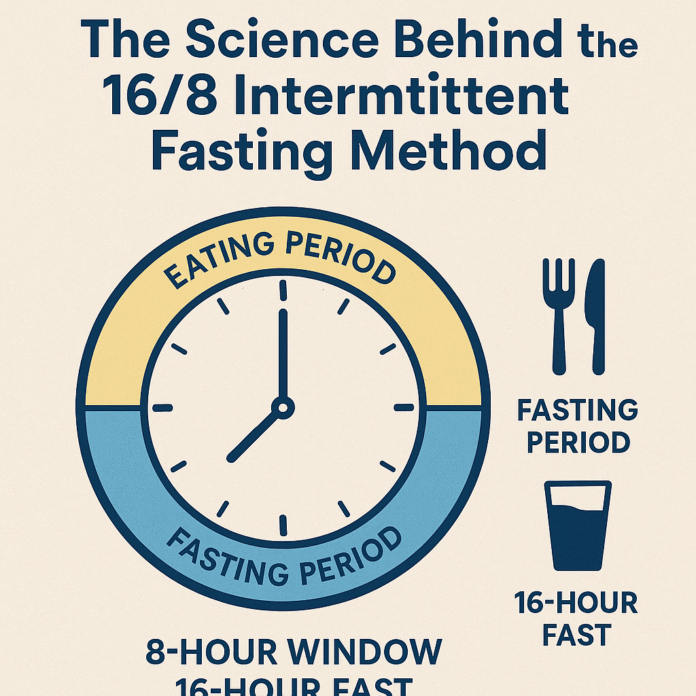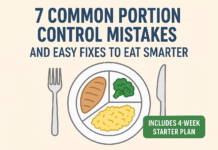Intermittent fasting (IF) is a flexible, science-based way to lose weight, speed up your metabolism, and stay healthy as you get older. A lot of people are talking about the 16/8 method, which is also known as time-restricted eating (TRE), because it’s simple to follow and stick to. The 16/8 plan says that people should not eat for 16 hours and then eat all of their calories in the next 8 hours, which is from 12:00 pm to 8:00 pm. The 16/8 method of intermittent fasting is based on scientific theories that are discussed in this article. It examines the physiological mechanisms, clinical evidence, benefits and drawbacks, and implementation strategies.
The 16/8 Method’s Physiological Basis: Switching Metabolism from Glucose to Ketones
Metabolic switching happens when the body stops using glucose that is already in the blood and starts using glycogen that is stored in the body. Then it keeps breaking down more fatty acids and making ketones. Studies on mice have demonstrated that time-restricted feeding induces metabolic switching, enhancing insulin sensitivity and reducing adiposity, even without caloric restriction.
A significant randomized study involving human subjects demonstrated that adults following an 8-hour feeding window (16/8 TRE) experienced considerable reductions in fasting insulin and blood pressure, along with a modest decrease in weight, compared to controls adhering to an unrestricted eating regimen.
Circadian Rhythms and Chrononutrition
Your body’s internal clock is controlled by circadian rhythms. These rhythms control hormone release, digestion, and gene expression to get your body ready for eating and not eating. Eating during the day can help your metabolism work better. A study in the Journal of Nutritional Biochemistry found that eating food early (between 7 a.m. and 3 p.m.) made the body more sensitive to insulin than eating late (between 12 p.m. and 8 p.m.). This shows how important it is to eat at the right times.
Results on Health and Clinical Proof
Changing the Way Your Body Looks and Losing Weight
- Getting rid of extra weight: Controlled studies show that people who follow the 16/8 TRE diet for 8 to 12 weeks lose an average of 3 to 5% of their body weight without having to count calories.
- TRE usually lowers fat mass while keeping lean muscle, which is a big plus over constantly cutting calories.
- People who are insulin resistant can lower their fasting insulin levels by up to 20% and increase their insulin signaling pathways by using fasting windows. This means that your metabolism is healthy.
- Blood Lipids: Studies indicate that reducing total cholesterol, LDL-C, and triglycerides can diminish the risk of cardiovascular disease.
Repairing Cells and Inflammation
Intermittent fasting starts autophagy, which is when cells get rid of damaged proteins and organelles to “clean up.” AMPK and mTOR are two important proteins that control autophagy. They react based on how much food there is. Cells are stronger and inflammation in the body is lower when autophagy is better.
Cognitive Health: It’s Not Just About Losing Weight
Neurons can use ketone bodies as a different source of energy. Animal and early human studies suggest that this may enhance neuroprotection, synaptic plasticity, and cognitive performance.
Reducing the Likelihood of Acquiring Cardiometabolic Disease
The 16/8 method could lower the long-term risk of heart disease and type 2 diabetes by improving blood pressure, lipid profiles, and insulin sensitivity.
Controlling Hormones
When you don’t eat, it changes ghrelin, which makes you hungry, and leptin, which makes you feel full. This can help you control your hunger over time and make you less hungry.
How to Make Your Life Last Longer
Preclinical studies demonstrate that intermittent fasting affects sirtuin and NAD⁺ pathways, mechanisms linked to lifespan extension via calorie restriction.
Things to Stay Away From and Possible Dangers
The 16/8 method is usually safe for healthy people, but it might not be the best choice for everyone. People who shouldn’t do TRE or need to change it are:
- Pregnant or nursing women
- Kids and teens
- People who have had trouble eating in the past
- People who take insulin or have type 1 diabetes
- People who have health problems that last a long time but don’t see a doctor.
Common short-term side effects include headaches, irritability, hunger pangs, and trouble concentrating. These usually go away after two to four weeks of getting used to the new situation.
The 16/8 Method: A Step-by-Step Guide
Choose your 8-hour time slot
- You can do it every day, from 10 a.m. to 6 p.m. or from 12 p.m. to 8 p.m.
- Maybe getting up early will help your metabolism.
Don’t rush to change
- Eat for 12 hours, then don’t eat for 12 hours. Every few days, add an hour to the fast.
Check the quality of the nutrients
- Eat whole foods like lean proteins, healthy fats, high-fiber vegetables, and some complex carbs.
- Don’t eat too much when you can eat to make up for it.
Water and salts
- When you’re not eating, drink water, black coffee, or tea with no sugar.
- Taking electrolyte supplements will help you stay awake and avoid headaches.
When to Work Out
- Resistance training may help the body make more protein for muscles during the feeding window.
- If you can handle it, you can do low- to moderate-intensity cardio while fasting.
Watching and Making Changes
- Every week, check your weight, body measurements, and energy levels.
- Change the times you eat and the kinds of food you eat based on how you feel and how well you can handle it.
Frequently Asked Questions (FAQs)
Q1: If I follow the 16/8 diet, will I lose muscle?
No. When you eat enough protein (1.2–1.6 g/kg body weight) and do strength training, the 16/8 method works better than continuous calorie restriction for keeping lean mass.
Q2: Is it okay to drink coffee when I’m not eating?
Yes, black coffee and tea without sugar have very few calories and can even make you feel less hungry. No sugar, cream, or milk should be added.
Q3: Is 16/8 safe for women?
Yes, most of the time. Women, on the other hand, may be more sensitive to not getting enough energy. If your periods are irregular or you are under a lot of stress, you might want to try a shorter fasting window (like 14/10) and see a doctor.
Q4: When will I notice changes?
People respond differently, but most people notice that their energy and appetite improve in two to four weeks. Weight loss and metabolic enhancements that are clinically significant generally appear within 8 to 12 weeks.
Q5: Can you work out if you’re not eating?
Yes, in most cases, it’s safe to do light to moderate exercise. For better performance and recovery, try to plan your high-intensity workouts during or right before your meal window.
In short, the 16/8 intermittent fasting method is a simple and scientifically proven way to lose weight, make your metabolism healthier, and maybe even live longer in a healthy way. You don’t have to count calories all the time to get long-term benefits from TRE. It does this by changing your metabolism, getting your circadian rhythms in sync, and controlling your hormones. You should check to see if the changes you make to your diet are good for you. Eat healthy foods, drink a lot of water, and take your time with the change. You should always see a doctor before you start a long fast, especially if you have health problems that could make it worse.
References
- Hatori M, et al. Time‐restricted feeding without reducing caloric intake prevents metabolic diseases in mice fed a high‐fat diet. Cell Metabolism. 2012;15(6):848–860.
https://pmc.ncbi.nlm.nih.gov/articles/PMC10002957/ - Moro T, et al. Effects of eight weeks of time‐restricted feeding (16/8) on basal metabolism, maximal strength, body composition, inflammation, and cardiovascular risk factors in resistance‐trained males. Journal of Translational Medicine. 2016;14:290.
https://pmc.ncbi.nlm.nih.gov/articles/PMC12006946/ - Tinsley GM, La Bounty PM. Effects of intermittent fasting on body composition and clinical health markers in humans. Nutrition Reviews. 2015;73(10):661–674.
https://pmc.ncbi.nlm.nih.gov/articles/PMC10945168/ - Gabel K, et al. Differential effects of early and late time‐restricted feeding on insulin sensitivity, blood pressure, and oxidative stress in men with prediabetes: A randomized crossover trial. Cell Metabolism. 2018;27(6):1212–1221.
https://www.cell.com/cell-metabolism/fulltext/S1550-4131(18)30253-3





































This is the perfect website for anybody who would like to understand this topic.
You understand a whole lot its almost tough to argue with you (not that I actually will need to…HaHa).
You certainly put a fresh spin on a subject which has been written about for ages.
Excellent stuff, just wonderful!